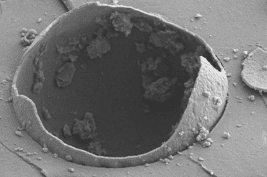 Polymer-matrix composites (PMCs) – commonly with epoxies as the matrix – reinforced with high-performance fibres are increasingly used in aerospace, aeronautic and automotive industries. These light-weight structural materials can reduce the weight of metal-based counterparts by up to 60%. Additional advantages include their highly tailorable anisotropic material properties and related high specific strength and stiffness; excellent formability and manufacturability; and superior immunity to corrosion. On the other hand, the architecture and layered structure of laminated PMCs means that although they exhibit very high in-plane mechanical properties, out-of-plane they often suffer from both low interfacial strength and interlamellar fracture toughness.
Polymer-matrix composites (PMCs) – commonly with epoxies as the matrix – reinforced with high-performance fibres are increasingly used in aerospace, aeronautic and automotive industries. These light-weight structural materials can reduce the weight of metal-based counterparts by up to 60%. Additional advantages include their highly tailorable anisotropic material properties and related high specific strength and stiffness; excellent formability and manufacturability; and superior immunity to corrosion. On the other hand, the architecture and layered structure of laminated PMCs means that although they exhibit very high in-plane mechanical properties, out-of-plane they often suffer from both low interfacial strength and interlamellar fracture toughness.
Various techniques have been used to try to prevent interfacial failure; in their informative Review published in the Journal of Applied Polymer Science, Xiang-Fa Wu (North Dakota State University) and Alexander L. Yarin (University of Illinois at Chicago) focus on recent progress in toughening and damage self-healing of PMCs reinforced with electrospun and solution-blown nanofibres. The nanofibres can be incorporated into the ultrathin resin-rich interlayers that have been shown to exist in laminated PMCs, producing nanofibre-reinforced interlayers with high strength and fracture toughness. Wu and Yarin also place emphasis on innovative processing techniques. Developments in high-efficiency, scalable fabrication of core–shell nanofibres mean that nanofibres loaded with healing agent can be used in PMCs. Such techniques facilitate low cost localized interfacial damage self-healing with low weight penalties.
Many questions still remain, and the mechanisms of such processes are as yet poorly understood. Wu and Yarin feel that the process and the rate of healing, along with accompanying preservation or recovery of material strength are attractive and important directions for future research.

















